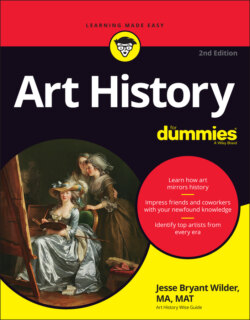Читать книгу Art History For Dummies - Jesse Bryant Wilder - Страница 127
The Classical period
ОглавлениеIn the Classical period (480 BC–400 BC), Kritios Boy (named after the artist who may have sculpted him) has learned to take it easy (see Figure 7-4). The artist has redistributed his weight. The left hip is now slightly higher than the right, and Kritios Boy’s bulk rests comfortably on his left foot instead of both feet as in the kouros (see the preceding section). The contours of the graceful thighs are utterly lifelike, as is the gentle swelling of the belly. The face, too, is more human than kouros faces; its still-masklike appearance is due to the holes where inlaid eyes used to be.
Notice the tension in the knees: The left is tight, the right relaxed, showing the distribution of weight. The sculptor has learned to represent a symmetrical young man’s body in an asymmetrical stance. The next step was to make the statue walk, run, jump, and throw — or at least appear to!
The bronze Charioteer of Delphi (circa 470 BC) is stiffer than Kritios Boy, but his upright posture would have helped him to be seen standing in a chariot atop a tall monument. The concentrated look in the charioteer’s face and the elegant, naturalistic folds of his robe are characteristic of early fifth-century Greek realism, also known as the severe style. The statue was commissioned to celebrate an athletic victory, a chariot race. Sports events were a big deal in Greece. During the Olympics, all warfare ceased so the Greeks could compete for laurel leaves instead of fighting for money and power.
The fact that the athlete was cast in bronze shows how highly the Greeks regarded sports heroes. They had godlike status, especially in their hometowns, where they were given a pension and free meals for the rest of their lives.
Tarker / Bridgeman Images
FIGURE 7-4: Greek statues begin to get comfortable around 480 BC. Kritios Boy is the turning point. The sculptor has learned to turn the body just enough to give him a relaxed look.
